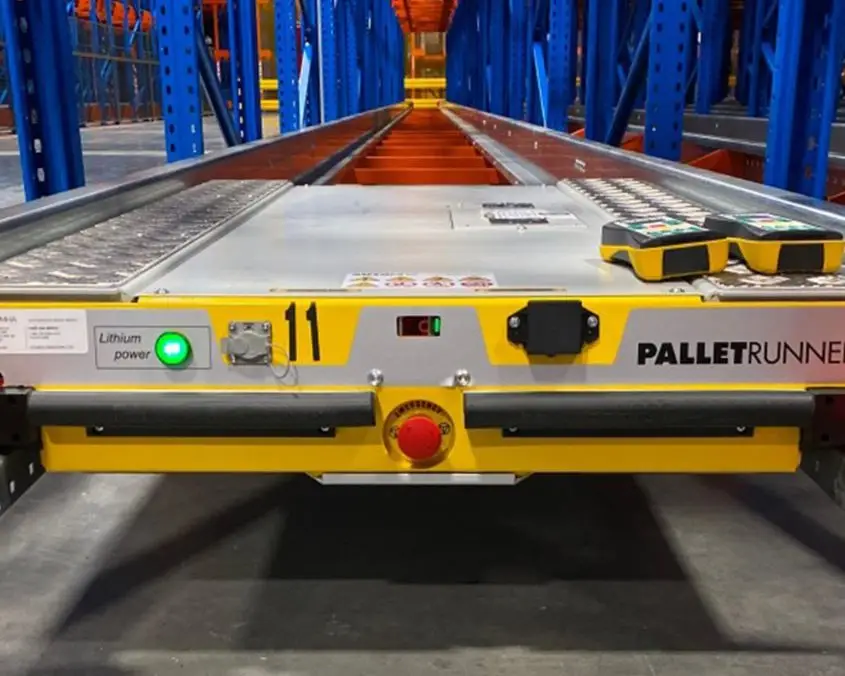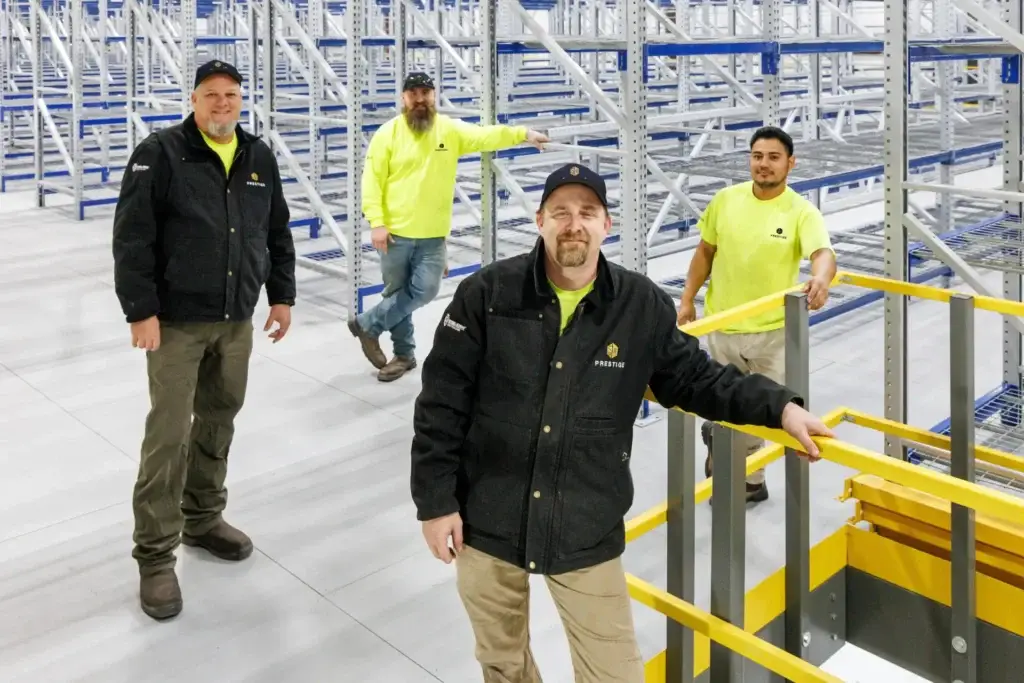Warehouse Automated Storage Systems

Empowering Efficiency
The Rise of Warehouse Automation
Warehouse automation refers to the use of technology and machinery to streamline and optimize various warehouse processes, from inventory management to order fulfillment. As e-commerce continues to grow and consumer expectations for faster delivery times increase, warehouse automation has become essential for business problems of all sizes.
There are many different automated systems that can improve your warehouse, from Vertical Lift Modules and AS/RS Cranes to Horizontal Carousels and Pallet Shuttle systems, click here to view all types of Warehouse Automated Systems that Prestige offers.
In today’s fast-paced business environment, efficiency is key to staying competitive. Automated warehouse systems have emerged as a game-changing solution for companies looking to optimize their operations, reduce costs, and improve productivity. Prestige is equipped to showcase the transformative power of warehouse automation and how it’s reshaping the logistics operations landscape.
Types of Warehouse Automated Systems
Automated systems offer diverse capabilities, from maximizing storage density to improving order fulfillment speed and accuracy. Five key types of warehouse automated systems that are revolutionizing the industry and driving operational excellence include:
- Vertical Lift Modules (VLMs): Vertical Lift Modules are automated storage and retrieval systems that utilize vertical space in a facility to maximize storage density. These systems feature trays that are arranged vertically on the front and back sides of the machine, and ultimately are delivered to an operator at an ergonomic position.
- Pallet Shuttle Systems: Pallet Shuttle Systems are semi-automated deep lane storage solutions that use battery powered carts to transport pallets within a racking structure. These systems offer high-density storage and are particularly useful for operations with a low number of stock keeping units (SKUs) and high volume. They eliminate the need for forklifts to enter deep lanes, improving safety and reducing the risk of damage to products and racking.
- Horizontal Carousels: Horizontal Carousels are rotating shelving units that bring stored items to the operator. These systems are ideal for operations with space constraints, as they can reduce the amount of floor space required for storage. Horizontal Carousels can increase picking speeds and accuracy, making them an excellent choice for order fulfillment operations.
- Mobile Racking: Mobile Racking systems consist of pallet racks mounted on motorized bases that can move along tracks in the floor. This system eliminates the need for multiple aisles, maximizing storage density while allowing direct access to any pallet when needed.
- AS/RS Cranes: Automated Storage and Retrieval System (AS/RS) Cranes are fully automated systems that use cranes to store and retrieve pallets or totes in high-bay structures. These systems can operate in narrow aisles and reach great heights, maximizing vertical space utilization. AS/RS Cranes are ideal for high-throughput operations and can significantly reduce labor costs and improve inventory accuracy.
Unlock the potential of your storage space – Contact our team for a free consultation!
The Key Benefits of Implementing Automated Systems
Automated warehouse systems offer numerous advantages that can impact a business’s bottom line and operational efficiency. From streamlining processes to enhancing safety and reducing long-term costs, these benefits demonstrate why more companies are turning to automation as a strategic investment. Here are some key advantages that make warehouse automation a game-changer in modern logistics operations and supply chain management.
- Increased Efficiency: By automating repetitive tasks and optimizing movement within the warehouse, these systems can significantly reduce the time required for order picking, packing, and shipping. This increased efficiency translates to faster order fulfillment and improved customer satisfaction.
- Space Optimization: One of the most significant advantages of automated systems is their ability to maximize warehouse space utilization. By using vertical space more effectively and reducing aisle widths, businesses can store more inventory in the same footprint or reduce their overall warehouse size.
- Improved Accuracy: Automated systems minimize human error in inventory management and order fulfillment processes. With advanced tracking and real-time inventory updates, these systems can achieve near-perfect accuracy rates, reducing costly mistakes and improving customer satisfaction.
- Enhanced Safety: Automated systems create a safer work environment by reducing the need for manual handling of heavy loads and minimizing forklift traffic. This leads to fewer workplace accidents and reduced worker fatigue, ultimately improving operational safety.
- Cost Reduction: While the initial investment in automated systems can be substantial, the long-term cost savings are significant. Reduced labor costs, improved inventory management, and increased operational efficiency all contribute to a strong return on investment over time.
Prestige's Automated Solutions Overview
Enhancing Efficiency and Precision
Prestige offers a range of warehouse automated systems to meet diverse operational needs. From Vertical Lift Modules to AS/RS Cranes, Prestige’s solutions are designed to optimize storage, improve efficiency, and drive business growth. With decades of experience in the industry, Prestige provides tailored automated solutions that integrate with existing warehouse operations.
- Integration with Warehouse Management Systems (WMS): To fully leverage the power of automated systems, integration with a robust Warehouse Management System is crucial. A well-integrated WMS can provide real-time visibility into inventory levels, optimize picking routes, and ensure coordination between automated systems and human operators. Prestige’s solutions are designed to integrate with leading WMS platforms to maximize operational efficiency.
- ROI and Cost-Benefit Analysis of Automation: Investing in warehouse automation requires carefully considering the return on investment. While the upfront costs can be significant, the long-term benefits often outweigh the initial investment. Factors to consider in a cost-benefit analysis include labor savings, improved accuracy, increased throughput, and space optimization.
Choosing the Right Automated System for Your Warehouse
Selecting the appropriate automated system depends on various factors, including the nature of your inventory, order profiles, available space, and budget. Conduct a thorough analysis of your current operations and future growth projections before deciding on a solution. Prestige’s team of experts can help assess your needs and recommend the most suitable automated systems for your specific requirements.
Warehouse automated systems are powerful solutions for businesses looking to streamline their operations. By carefully selecting and implementing the right automated solutions, companies can significantly improve efficiency, accuracy, and overall performance. As technology continues to advance, the future of warehouse automation looks brighter than ever, promising even greater innovations and opportunities for operational excellence.

Building Success Through Storage
Our Full-Service Team
At Prestige, we pride ourselves on our unmatched inventory and ability to quickly ship products at competitive rates. Our expertise extends beyond product supply – we offer comprehensive turnkey project management and installation services, with skilled crews capable of traveling nationally.
Our core values of Quality, Integrity, Adaptability, Customer Focus, Hard Work, and Teamwork drive everything we do. We’re not just selling products; we’re partnering with our clients to identify optimal storage and material handling solutions, supporting them from initial sale through installation and aftermarket service.
With Prestige, you’re choosing a partner with over five decades of industry experience, a wide range of new and used equipment options, and a dedication to helping you maximize your operational efficiency. Whether you’re looking for traditional storage solutions, space transformation, or cutting-edge automated systems, Prestige has the expertise and resources to meet your unique challenges.
FAQ
Commonly Asked Questions
What is warehouse automation?
Warehouse automation refers to the use of technology and machinery to streamline warehouse processes, including inventory management, order picking, and shipping. It involves implementing systems like autonomous mobile robots for product picking, conveyor belts, and automated storage and retrieval systems to reduce manual labor and improve efficiency. These technologies work together to create a more streamlined, accurate, and efficient warehouse operation.
How does warehouse automation improve efficiency?
Warehouse automation improves efficiency in several key ways. It significantly reduces manual labor and human error, leading to more accurate inventory management and order fulfillment. Automated systems can process orders much faster than manual methods, increasing overall throughput. Space utilization is optimized as automated systems can often operate in tighter spaces and make better use of vertical storage. Inventory accuracy is enhanced through real-time tracking and automated counting. Additionally, many automated systems can operate 24/7, further increasing productivity. All these improvements contribute to faster order fulfillment, reduced operating costs, and ultimately, increased customer satisfaction.
What are the main types of warehouse automation systems?
There are several main types of warehouse automation systems, each designed to address specific operational needs. Automated Storage and Retrieval Systems (AS/RS) efficiently store and retrieve items from high-density storage areas. Automated Guided Vehicles (AGVs) transport materials around the warehouse without human intervention. Robotic Picking Systems use advanced robotics to select and pack items for orders. Conveyor Systems move products efficiently through different areas of the warehouse. Sortation Systems automatically direct items to specific locations based on predefined criteria. Vertical Lift Modules (VLMs) maximize vertical space for storage and retrieval. Automated Packaging Solutions streamline the final stages of order preparation. Each of these systems can be implemented individually or as part of a comprehensive automation strategy, depending on the warehouse’s specific requirements.
